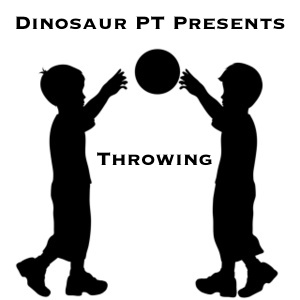
to throw
Throwing is a ball sports skill that we as pediatric physical therapists address. Throwing requires upper body strength, hand-eye coordination, motor planning and body/spatial awareness. As with all developmental milestones, motivation, engagement and practice are key!
throw milestone
- Rolling forwards: 8-12 months
- Flinging Ball (throwing the ball in any direction): 12-14 months
- To throw a ball (by extending arms at shoulders or elbows while maintaining balance): 15-18 months
- Forehand Throw (Thrown at least 3 feet forward in the air): 19-22 months
- Underhand Throw (throw at least 3 feet forward in the air): 23-26 months
- Throwing Forehand Throw (moving arm up and back, 7 feet in the air): 26-30 months
- Underhand Throw Form (arm moves down and back, 7 feet in the air): 29-36 months
- Forehand throw 10 feet (use upper torso rotation to move arm up and back, arms and legs facing each other): 38-42 months
- Low hand hit on target (from 5 feet): 38-42 months
- Forehand on target (from 5 feet): 43-46 months
- Low Hand Throw 10 Feet (using upper torso rotation, arm and leg reverse movement arms down and back): 45-48 months
Teach your child how to throw
start with scroll

Rolling back and forth teaches children about turn, cause and effect, and helps build an understanding of ball games. Rolling the ball can also solve visual tracking and hand-eye coordination problems.The best balls for practicing rolling include music ball, rattle balland tactile ball.
try to maneuver the ball easily
 O-ball is a great tool as it is lightweight, promotes a double-sided grip, easy one-handed operation, interlocking fingers for grip and quick release. Start by rolling the ball back and forth. Let the children become familiar with the ball and understand the movement of the ball. From the floor, encourage the child to stand and hold the ball. As children gain trunk and upper body strength, they will now be able to hold and release the ball. First is throwing the ball and eventually being able to manipulate the ball for throwing.
O-ball is a great tool as it is lightweight, promotes a double-sided grip, easy one-handed operation, interlocking fingers for grip and quick release. Start by rolling the ball back and forth. Let the children become familiar with the ball and understand the movement of the ball. From the floor, encourage the child to stand and hold the ball. As children gain trunk and upper body strength, they will now be able to hold and release the ball. First is throwing the ball and eventually being able to manipulate the ball for throwing.
reduce the size of the ball

initially was big ball Great for practice; it provides a larger target, engages the whole body for grip and maneuvering, and promotes forward propulsion of the hands.begin to decrease as the child gains strength and comfort ballEncourage children to manipulate the ball with one hand at a time.
change target

It’s always great to practice throwing back and forth at another person, but you can try other goals as well.For example, rolling or throwing a ball to knock down Bowling pins, colorful cones or block tower Both are great ideas for practicing accuracy and aim and throw skills. Throwing clothes in the laundry basket is a great prerequisite for practicing with a kids basketball hoop at home or on the playground. bean bag toss Also a fun way to tackle throwing targets!
Overhand and Underhand Throwing Models
Start modeling throws and underhands. Children can watch older peers, siblings or adults demonstrate these skills. We can then use physical cues (hand-to-hand) to help develop motor patterns by having the child perform underhand and overhand throws. Verbal cues can also help.

For an overhand throw, we say “put it to your ear and throw!”

For underhand throws, we say: “Swing and throw by your side!”
generalization skills



In order to generalize throwing skills, it is important to practice the same skill in different settings with different equipment. You can increase the challenge as your child develops skills and builds confidence. In the series of photos above, Abe practiced shooting from increasing distances to basketball hoops of varying heights. This helps generalize the skill of throwing targets.

we hope you like teach children to throw!For more fun ideas to encourage throwing, check out our this week’s activities!

For more ball trick fun, check out teach children to catch!
learn more about dinosaur physiotherapy!
To continue the conversation, follow us Facebook and instagram


